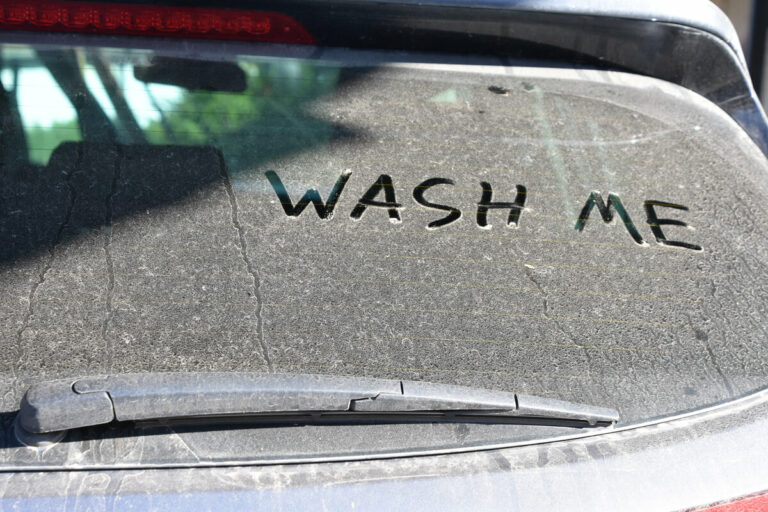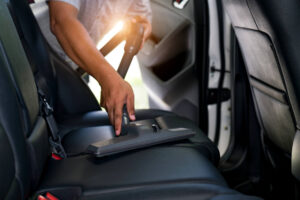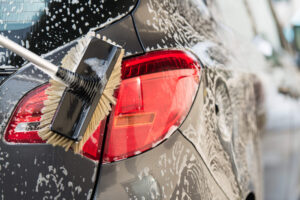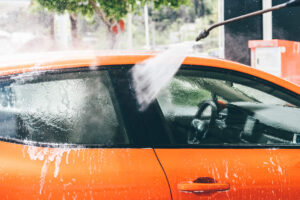Why Professional Car Washes are Better Than Washing At Home
Your car is not just a means of transportation. It is also an investment. As such, it is only logical that car owners get cars washed, because regular washing is necessary if they want to maintain their car’s condition as well as they can.
However, washing a car properly is not an easy task. It often takes a lot of time, and as a result, many people wash their car in an automated car wash. Still, many people opt to wash their car by hand at home. These DIY car washers usually think they are saving money or doing a better job than the professional car wash. However, this may not be the case. It is important to break down the pros and cons of hand washing and automated car washes.
Before diving into the benefits and drawbacks of each method of washing cars, it is important to understand the basics of car washing and what makes a good car wash good.
Car Washing Basics
Whether washing by hand or by automatic drive through, car owners should understand the necessity of doing it right. It’s a critical step for car maintenance, which means that if the car is going to be sold, it is also necessary for maintaining the resale value of the vehicle. Even if you do not have any plans to sell the car, washing can save a lot of money in costs from getting new paintjobs, preventing rust and scratches, replacing wheels and tires, and preventing external parts from corroding or getting clogged up by dirt and gravel.
Washing a Car at Home
All it takes to wash a car at home is a few buckets of water, protective gloves, a strong hose with a spray nozzle attachment head, and soap. Of course, it is also important to select the right location to perform the car wash. This should be somewhere without direct sunlight or strong heat, because this will cause the soapy water to evaporate and leave residue dried on the car that can eat away at paint and accelerate the corrosion of external parts. As such, it is ideal to wash the car in the late evening or early morning, or in an indoor garage (which optimally has a drain or slanted floor that allows the water to run off during washing). Do not wash the car under a tree where leaves, twigs, buds and bugs can fall onto the car and stick to it, creating much more work in the long term. Another bad location is anywhere near dusty road, since the dust can also stick to the car and cause similar problems.
Make sure the hose has a nozzle that has sufficient pressure to spray down the vehicle. The nozzle should also be able to cut off the flow of water whenever necessary to prevent waste. This saves on water bills, and also makes the whole process a lot less messy.
Once it is time to begin the car wash and a good location has been selected, start off by focusing on the wheels and tires. The wheels are usually the messiest part of the car, and since high pressure spraying can blast dirt and debris off (which will then stick to other parts of the car, particularly the undercarriage), it is best to clean them before any other part of the vehicle. Stary by spraying around the wheel wells, knocking off any dirt and debris present. Make sure to get rid of brake dust and remove any road salt left over from winter driving, and clear out any gravel, branches, or other material stuck in or around the wheels.
Consider cleaning the wheels with a cleaner that is specifically designed for them. Wheel and tire cleaners are sometimes formulated for certain types of paint or metal. Finding out the best type of cleaner is usually as easy as referring to the vehicle’s owner’s manual. Do not take the risk of damaging the wheels or paint job by using the incorrect product. Use a mitt or chamois to wipe down the wheels. When finished with each of the car’s wheels, put the chamois or mitt aside, since it is possible to transfer all of the debris and tire dirt to the rest of the car, creating more work and potentially even scratching the paint.
Next, it is time to prep and lather. Spray down the entire car with water to help remove dirt on the external surface and give the car a coating of moisture. Make sure to blast all especially dirty spots with the high-pressure hose nozzle, moving it back and forth over the dirty spot slightly. Change the angle and distance as necessary to remove the dirt. Target the cracks and crevices of the vehicle with special attention, and be sure to carefully and methodically go over the whole body of the car.
Fill two buckets with water, and prepare one of them with soap (ideally with the soap stirred in slowly, so as to be mostly dissolved but not too foamy). Again, it is critical to use a soap and/or cleaning solution that is specific to the car, the metal of its frame and external components, and most of all the type of paint it has. The cleaning solution or soap should be as specifically designed for the car’s external body as a household cleaning solution would be for the item it is meant to clean. Otherwise, there is a very significant risk of damaging the finish, hurting the paint job, and more. Selecting the right soap is half the battle.
“Don’t use household cleaning agents like hand soap, dishwashing detergent, or glass cleaner on the paint,” says Consumer Reports. “These aren’t formulated for use on a car’s paint and may strip off the protective wax.”

Information about what cleaning materials and equipment to use for car washing can often be found in the owner’s manual, but this might be a reason to use a professional car wash. Whatever the case, a properly suited car cleaning solution will allow the water to sheet and then bead off, which makes the whole process of drying and evaporating much faster, and drastically cuts down the probability of water spots that can make vehicles look dirty. This is a mostly aesthetic problem, but since one of the major reasons for cleaning a car is the aesthetic value that car washing provides, leaving water spots will largely render the hard work put into cleaning the car pointless. However, in some cases, this can end up eating away at the car’s paint job or causing problems with corrosion of exterior parts – but this should not usually be a huge concern, as long as the appropriate cleaning solution or soap is used.
When filling up the bucket with the soap or the cleaning solution, make sure to carefully follow the instructions on the cleaner. This ensures that the concentration of the cleaner is not too high (which can leave the car’s body damaged or covered in soap stains) or too low (which can allow dirt and grime to remain on the car, also rendering the hard work of car washing pointless). The bucket with the soap or cleaning solution will be used to lather up the mitt, rag, sponge, or chamois, and the bucket of water will be used to wash off the bucket with the soap or cleaning solution, and to rinse the dirt and debris off these scrubbing tools. Make sure to fully rinse and wring out the scrubbing tool (especially if it is a sponge or high absorption rag) between cleaning each section of the vehicle. This helps prevent soap spots and transfer of dirt and debris between different areas of the vehicle, and is especially important because the cleaning/scrubbing tool can seriously scratch the car’s paint job during cleaning if debris like twigs, gravel, or sand is stuck on the tool when it is scrubbed with any degree of pressure against the external surface of the car.
In general, while washing the car, it is best to begin at the top of the car and work your way downward while methodically cleaning it in sections. This also helps to protect your vehicle.
“Clear coat scratches are what makes your car look dull and lack luster. Pretty much every car has them,” says Auto Care HQ. “One of the best things you can do to avoid inflicting these kinds of scratches is washing your car from top to bottom.”
Starting with the roof of the car, use the rag, mitt, sponge, or chamois to make a single, long swipe across the whole area being cleaned. Then turn the scrubbing tool over and use the opposite side to swipe a second time, before wringing out the scrubbing tool fully and rinsing it fully. It is not a good idea to scrub with high pressure or to simply try to rub off the dirt, since this increases the chance of scratching the paint or leaving the dirt on the paint job.
While finishing each section of the vehicle, give that section a rinse so soap or cleaning solution doesn’t end up sitting on the paint job and evaporating, leaving a scummy residue. Clean the back portion of the vehicle last, since that area has a lot of dirt. A lot of car owners can be half-finished cleaning the back, see how dirty the rest of the car is in comparison to it, and be tempted to move on before they’ve really cleaned it. A good mnemonic to remember this is that the last part of the car to clean is the last part of the car that passes through a tunnel or over a line in road. You clean a car just how you read the pages of a book: top to bottom, front to back.
If the mitt, sponge, chamois, or rag falls on the ground during the car washing process, make sure to fully rinse it and get all the dirt and debris off before even thinking about using it on the car again. Dirt, sand, or gravel can easily become lodged into it, and it is a very bad idea to rub that against the car’s paint job. Take a moment to inspect it carefully to ensure that it is free from any debris that could scratch the car’s surfaces.
After carefully cleaning each section of the vehicle, take the spray nozzle off of the hose. Then, use the normal free flowing water to rinse the vehicle and wash any residual soap or cleaning solution off. Again, start from the top and work downward from there, and again, try to generally move from front to back. Do not leave any soap behind, since this can cause the same aesthetic problems – and even external part corrosion and paint damage – mentioned earlier.
Finally, use a microfiber cloth (the same kind used to clean eyeglasses) or a dry chamois to gently and methodically dry the vehicle. Like the washing and rinsing process, it is a good idea to work in sections here and move in the top to bottom and front to back direction mentioned earlier. Be cautious about using the right tool for the job, too; household towels should be avoided. It is better to instead use a microfiber cloth or a chamois to absorb any leftover moisture, draping the cloth over the car with minimal pressure or rubbing. If the cloth starts to really absorb a lot of water and get wet, wring it out and squeeze the water out as you continue to dry. After finishing the drying process, double-check each section of the vehicle for residual moisture. Run a finger along the surfaces of the car to make sure it is fully dried.

Washing a Car at a Professional Car Wash
It can certainly be said that one advantage of using a professional car wash is that it doesn’t require much effort. An automatic car wash usually just involves paying, driving in the wash bay, putting the car in Park when the machine prompts you to stop, and letting the mechanical cleaning devices do their job. Since going through an automatic car wash doesn’t require a lot of effort, car owners usually find that it is more important to focus on finding a high-quality car wash service that will not fail to clean the car properly or even damage the vehicle.
- Opt for a modern car wash with new equipment. Although many people just drive down the road and pull into the first car wash they see, it is smart to take a moment to examine the equipment they have available before paying and putting your car on the line. And car washing technology has come a long way in recent decades, so newer systems also give the car a better clean. When in doubt, you can ask the employees how old their system is.
- Opt for an experienced car washing business. Although you want the equipment and the mechanics of the car washing system to be new, you don’t want the company to be inexperienced. The ideal car washing service is one that has decades of experience, but a consistently upgraded and improved system. A company that has continued to expand and grow over the years is a sure sign of quality.
- Check the reviews. Since a very expensive piece of property (a car) is at stake, the least you can do before choosing a car wash is take a minute to check out the reviews online. Don’t rely on the company’s website alone. Many less than reputable car washes write their own reviews and testimonials and share them on their website, or delete any negative reviews. Look for a company that shares independent reviews and ratings from Google Reviews, Trustpilot, or the Better Business Bureau, and then go to those sites directly to confirm that the car wash is reliable and safe.
- Pull in and look. This lets you observe how old the car wash appears to be, and also get a general read of the quality of the business. Take note of the cars coming out of the wash. If they are clean, the car wash is doing its job. If they are dirty, still soapy, scratched, or have other problems, that is a major red flag. Also have a look at the building and machinery. If it is well-cared for, that is a good sign. But if there is rusted machinery, chipping paint, cracked walls, unpaved asphalt or concrete, or similarly concerning flaws, then that is also a red flag, and it is time to go elsewhere. A car wash that is maintained well and cared for means that the people operating it are taking the time to make sure their customers are pleased. That means a safer and happier experience for you, and it probably means a cleaner car.
- Is it cheap, or is it too cheap? Car washes that charge very little can often have a hidden cost. They might save money in the short-term, but they can hurt your car – and even if they were free, the savings would never be worth the bill from the mechanic. Cheap car washes can use caustic soaps that remove dirt easily but damage the finish and paint job of the vehicle. They often fail to replace dirty towels, leaving the cars they wash dirty and scratched. They may use brushes that are too harsh for the car. Worst of all, cheap car washes might be rushing the wash. A quality car wash will apply soap at the beginning of the wash, then give it a few seconds to soak in. But cheap car washes will immediately get to scrubbing. This step, known as “presoaking,” prevents dirt from simply getting dragged along the surface of the car, rather than being properly washed off by the wash. The soaps car washes use are not just soap, they also contain surfactants and lubricants that break the bond between the dirt and the surface of the car. But that process takes time, which is why presoaking is so vital. Remember: your car is an investment. An affordable car wash is good, but a dirt-cheap car wash will leave your car dirty, and cheap.
There are a few other considerations to make when choosing a car wash. These are common services that many car washes offer that may or may not be right for you and your car, but it is important to know what they are and how worthwhile they could be before spending extra money on them.
“Touchless” car washes are a type of wash that use a powerful, high-pressure water spray and a blend of certain chemicals to remove dirt and other materials that can stick to cars. Most modern car finishes are strong enough to withstand any kind of wash, including touchless washes, but washes that use old, poorly maintained brushes or bristles can cause problems. If they are properly maintained according to the design of their manufacturer, touchless car washes will certainly not harm the car’s paint job or finish.
However, there sometimes disreputable car washes fail to properly maintain their touchless car wash systems and do not keep them in good condition. That can cause problems. Glossy black exterior trims, for example, can end up getting scraped and scratched by washes that use hard or poorly maintained bristles if they begin to fray, split, or get sharp edges on their ends. That is why it is always a good idea to have a look at the brushes before taking a car through a wash, if at all possible. Make sure the brushes are clean, and do not have any dirt engrained in them, which could easily damage a car’s exterior (especially glossy or black exteriors). Dirty cloths or brushes can transfer dirt from one car to another, too. In general, if you use a well-maintained car wash company, you shouldn’t have to worry about any of these issues.
Another option many car washes offer is undercarriage washing. This is a good service, and it can be especially helpful for those who regularly drive through mud, drive off road, drive on gravel roads, or especially for those who live in a region where roads are salted during the winter season. They can cause significant damage and rusting of external car parts on the undercarriage, and according to Carwash.com:
“Salt buildup on vehicle surfaces is corrosive, and the sand, dirt and snow that accumulate can trap moisture in wheel wells and underbody structures, according to Dan Kramer, technical director with Stone Soap Co. Inc. Stones and rocks can further chip any underbody protection.” The undercarriage can be a trap for various materials that cause damage and corrosion. A touchless car wash has enough pressure to blast those materials away, and also chemicals that prevent rust formation and neutralize the salts that can be present.
The last major service that car washes offer that car owners should be aware of is wheel cleaning. If the goal is just to remove brake dust, this can be a good option. Brake dust is the black powder that often builds up on the rims of wheels, and since it has very different chemical properties compared to salt and grime from roads, it must be removed with a different kind of special cleaning solution. However, the accumulation of brake dust is almost entirely an aesthetic problem. Unless the appearance is a big issue, the wheels are not threatened by brake dust.
To DIY or Not to DIY?
Having now covered all the ins and outs of both DIY car washing and getting a professional automated car wash, it is time to examine the pros and cons of each method.
Washing your car at home certainly seems like cheaper option. Outside the cost of cleaning materials, it costs far less to wash the car by hand than take it to a professional car wash. However, there are hidden costs in the long term. First of all, there is the risk of making a mistake while washing the car that ends up cutting into your car’s paint job, and into your bank account.
Remember that all it takes to make these expensive errors is getting a tiny piece of gravel lodged in a cleaning mitt, or a piece of debris falling onto the car from a tree overhead. Washing by hand has a lot of these risks, as mentioned earlier. Using the wrong sponge or soap can damage the car. Using any type of soap or cleaning solution that is not made for cars, or not compatible with your car, can cause permanent damage. Using a sponge or brush that is too rough can end up creating little scratches on the finish of the car. Forgetting to dry the car after washing or missing a spot when rinsing can create water spots or soap stains, and the dissolved minerals and chemicals left behind can damage the car. At a professional car wash, however, powerful blow dryers dry cars far better than any chamois ever can. Trees and gravel are not a possibility. There is virtually no risk of scratching or damage to the finish.
Another benefit of a professional car wash is the prevention of undercarriage damage. Salt and other chemicals that accumulate on the undercarriage of a car can cause a variety of problems, from paint damage to corrosion of external parts. Many DIY car washers do not even consider washing their undercarriage, but even if they do try and clean under their car, they will not be able to reach all the nooks and crannies that a professional car wash machine can. Hitting the undercarriage with the right blend of chemicals, at the right pressure, at the right angle is extremely tricky – and doing it at home is simply not realistic.
It is also important to consider the environmental impact. Professional car washes use around 60 percent less water over the entire wash than a homeowner uses just for rinsing. Driving a car on its own is enough of a burden on our environment, and DIY car washing has been identified by water quality experts as a major cause of water pollution and water overuse. Unlike home washing, professional car washes have well-designed drainage systems to prevent toxic chemicals and dirty water from harming the environment. Car wash system manufacturers have calculated the precise amount of water and soap necessary to wash a car. Many car washes even recycle their water. Some car washes even go the extra mile and design their systems to save electricity and gas, too.
And, of course, a professional car wash saves time. Washing a car at home is a lengthy, exhausting process. Rushing it is a surefire way to damage the car or leave dirt and debris on the vehicle. It takes about an hour on average to fully clean a car – and that’s just the exterior. But getting it professionally washed means having all of that done in 10 minutes, and it should cost no more than $20.
It’s safe to say a professional automated car wash is the way to go, but all these advantages only apply to a quality car wash service. Unfortunately, a lot of car wash companies are not exactly reliable. Many low-quality car washes are owned by people who see them as a business that requires minimal effort. They think they can just buy the business, sit back, and collect money as it runs itself. After all, most car washes nowadays are self-service and largely (if not entirely) automated. But they make a key mistake: they underestimate the maintenance and management a car wash needs to run well. A hands-off management style tends to make car washes less safe, less effective, less reliable, and overall, not worth the cost – even if they are cheap. If you’re in the Lancaster County area and you’re looking for a quality car wash, check us out here: Sundance Car Wash.





